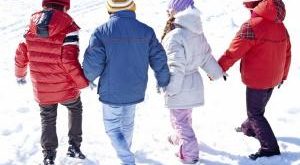A little preparation can go a long way toward full enjoyment and high performance levels during colder weather. Samar Bashour, MD, of Cleveland Clinic Pediatrics, offers the following advice for preparing your child for the cold of winter.
Sunscreen—even in winter
We don’t think about it, but sunburn can happen when the winter sun reflects off of the snow. Be sure to apply waterproof sunscreen and a protective lip balm to your child’s face before going outdoors.
It’s all about layers!
Minimize how much skin is exposed and dress them in layers. Cotton fabric should not be worn close to the skin, as it traps moisture which can attract the cold. The layer closest to your child’s skin should be a moisture-wicking material, like lightweight polyester or polypropylene. This will take moisture away from your child’s skin to the outer layers where it will evaporate. The second layer is the insulating layer, which should be wool or polyester fleece. The third, outer layer ought to be wind and rain repellent and waterproof.
Pay attention to appendages
Be sure to cover your child’s head with a warm hat to decrease heat loss. If finger dexterity is not important for your child’s cold weather activity of choice, have them wear mittens instead of gloves. If gloves are necessary, consider wearing a thin liner under the gloves for better insulation.
Dry, warm feet are essential for decreasing the risk of a cold weather injury and preventing blisters. Socks should wick moisture away from your child’s feet to the boot. Avoid cotton socks. Cotton keeps moisture next to the skin. More appropriate fabrics include wool or synthetic fibers with a moisture-wicking capability. If you layer socks, be sure the boot is large enough to ensure proper circulation for your child.
About frostbite
Children are at an increased risk of hypothermia. Take temperature and wind chill into consideration and keep exposure to cold to a minimum by setting limits on the length of time children can be outside.
Know the warning signs of frostbite. Hands, feet, nose and ears are most likely to be affected and may feel itchy, burning or numb if they have it. In extreme cases, skin color may be grayish yellow in color and feel hard or waxy. If any of these symptoms occur, it is important to gradually warm the affected areas. Do not apply direct heat from a stove, fireplace, heating pad, etc., as burns could result due to the numbness or lack of feeling. Seek medical attention if blisters form or pain remains during the gradual warming process.
The good news is that cold weather does not cause colds – colds are caused mainly through the spread of viruses. If you follow the above tips and encourage your kids to avoid getting wet by keeping hats and gloves on at all times, they can enjoy a fun and active winter outdoors.
 KidSports A Parents Guide for Young Athletes
KidSports A Parents Guide for Young Athletes 